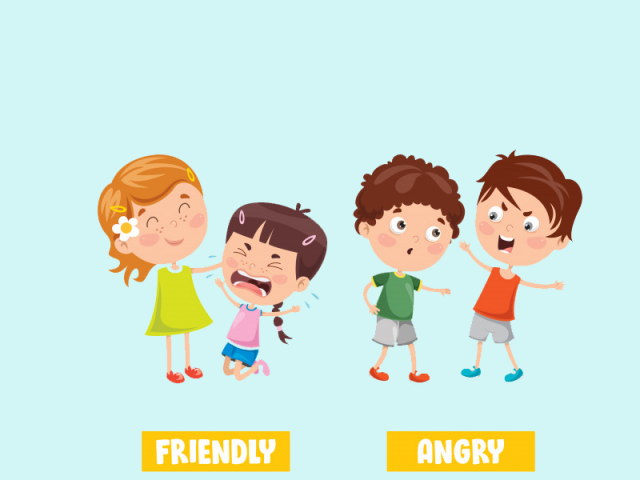Types of adjectives
Adjectives are common words in English vocabulary. Adjectives also have many types like nouns. Memorizing adjectives by type, in addition to being applied to English grammar exercises, also helps learners easily learn vocabulary. Understanding that, EnglishTopVN summarizes everything about adjectives in English in the article below, hoping it will be useful to many of you.
1. Concepts
Adjective (adjective or abbreviated as adj) are words used to describe, talk about the characteristics, properties of events, things, people, phenomena...
For example:
- Adjectives that describe people: Clear (healthy, sharp-minded), Athletic (strong, healthy), Well-proportioned (beautiful and balanced)…
- Adjectives that describe personality: Gentle (gentle), Diligent (hard-working), Sensitive (sensitive)…
2. Levels of adjectives
Depending on the context and content that the subject wants to express, adjectives will have different levels such as: positive, relative and absolute. Here are some examples of adjectives in English for each level:
2.1. Active adjectives
Used to describe, not to compare.
For example:
- This is a beautiful girl.
2.2. Relative adjectives
Used to compare two things (comes with coal).
For example:
- This girl is more beautiful than that girl.
2.3. Absolute adjectives
Used to compare 3 or more objects, showing that the characteristics of any object/event are the best.
For example:
- This is the most beautiful girl that I see.
3. Classify adjectives
Similar to nouns or verbs in English, adjectives in English are also divided into many different forms depending on their uses and purposes.
3.1. Descriptive adjectives
Descriptive adjectives are included in concurrent noun phrases modifies nouns. These adjectives are used to express the nature of things, events.
For example:
- Small, Big, Short, Thin, Fat
Position of descriptive adjectives:
In a noun phrase in a sentence, this adjective must comes after determiners like the article "a, an"... as well as standing before a noun and modifying that noun.
So if in a sentence, we use many adjectives at the same time to modify the noun differently, what should we do? Will their location change?
Types of adjectives in English have been conventionally forced to be arranged in the following sentence order:
- Opinion – Size – Age – Shape – Color – Origin – Material – Purpose + Noun
(Opinion – Size – Age – Shape – Color – Origin – Material – Purpose + Noun)
For example:
- a big blue plastic bottle.
- a square glass table.
- a short narrow street.
In the case of a situational context where we use 2 adjectives of the same classification, then we will connect those 2 adjectives with the word and.
For example:
- a new black and white T-shirt.
- a beautiful white and pink dress.
- blue and red velvet curtains.
3.2. Possessive adjectives
Among the types of adjectives in English, this is probably the most common and common type of adjective. Possessive adjectives are used to indicates the ownership and sovereignty of that noun. For each different personal pronoun, there will be a separate adjective form:
| Throne | Singular | Many |
| First Person | My | Our |
| Second person | Your | Your |
| Third | His
Her Its |
Their |
For example:
- My table.
- His friends.
- Their house.
4. Types of adjectives
4.1. Descriptive
How to use adjectives in English for form descriptive adjective This will usually provide information and value for the thing/event and the object.
For example:
- A beautiful girl.
- A sweet girl.
4.2. Quantitative
In written and spoken style, quantitative adjective to express and talk about the quantity/mass of a certain object. Therefore, it often answers questions like “how many” or “how much”.
For example:
- How many staffs are there in his company?.
- He has thirty-three staffs in company.
4.3. Demonstrative
There are different types of adjectives in English indicative adjective used to describe the pronoun or noun that the subject wants to mention, including the words: these, those, this, that.
For example:
- Which car would you like to give her?
- I would like to give that one.
4.4. Possessive
Possessing also known as positive adjectives used to talk about the owner of the object and commonly used possessive adjectives such as: your, his, her, our, their. In case you want to omit pronouns or nouns, you just need to replace them with: yours, his, hers, ours, theirs.
Attention
- For the owner to be an indefinite pronoun: one will have the possessive form one's
- For owner are words like: everyone -> their
For example:
- This is my car. = This car is mine.
4.5. Interrogative
Interrogative adjectives used when you want to ask a question, it always comes with a noun or pronoun. Suspicious features will include: which, whose, what.
For example:
- When “Which” is an adjective in the sentence: Which house is your favorite?
- When “Which” is not an adjective in the sentence: Which is your favorite house?
4.6. Distributive
Distributive adjective i is used to describe a specific element in a group. Some distributive adjectives you often encounter: any, either, every hoặc each. This adjective will always go with a noun or pronoun.
For example:
- Each company has its rules.
4.7. Articles
A, an, the is 3 article in English.
- A: Singular, begins with a consonant and refers to a common object.
- An: Singular, beginning with a vowel and talking about a general object.
- The: Can be singular or plural, referring to a specific object.
4.8. Adjectives indicating count or ordinal numbers
For example:
- one, two, three…
- first, second, third…
4.9. Contact adjectives
Are adjectives that have the same form as relative pronouns.
For example:
- Whichever, Whatever
5. Adjectives with endings -ing and -ed
As for the types of adjectives in English, this is the type of adjective that makes foreign language learners feel confused and confused when doing grammar exercises or even using them in daily conversations. day.
Adjectives with ed ending: Expresses the speaker's feelings about a certain object, event or phenomenon.
For example:
- He’s interested in listening this song.
Adjectives with ing ending: Expressing or talking about something that gives the speaker a feeling or emotion.
For example:
- It is an interesting song.
Some pairs of adjectives ending in –ing and –ed:
- Shocking – shocked
- Confusing – confused
- Frightening – frightened
- Amusing – amused
- Exhausting – exhausted
- Astonishing – astonished
- Embarrassing – embarrassed
- Exciting – excited
- Terrifying – terrified
- Worrying – worried

How to use adjectives in English
6. Compound adjectives
With types of adjectives in English, besides original and regular adjectives, there are also a few other forms to create adjectives in English:
From two single words to form adjectives:
- Money-making
- Nerve-wracking
- Record-breaking
- Hair-raising
- Heart breaking
- Top-ranking
Structure of compound adjectives in English:
6.1. Noun + Adjective = Adjective
For example:
- Life + long = lifelong
- Snow + white = snow white
6.2. Adverb + Participle = Adjective
For example:
- Well + known = Well-known
- Well + done = Well-done
6.3. Adjective + Participle = Adjective
For example:
- Ready + made = Ready-made
- High + paid = High-paid
7. Position of adjectives
There are 2 common positions of adjectives in English: adjective comes before the noun and adjective standing alone.

Placement of adjectives in English
7.1. Adjectives placed before nouns
In English, these adjectives, when placed before N (noun), will combine to form a noun phrase:
For example:
- A big house
- A good boy
7.2. Adjectives stand alone
Aware, ashamed, alone... and a few other adjectives such as: unable, exempt... these are adjectives in English that usually stand alone.
For example:
- That girl is alone.
After the linking verbs below, we can completely use them in English:
- Tobe
- Seem
- Sound
- Smell
- Feel
- Taste
- Look
8. Signs to recognize adjectives
Types of adjectives in English are quite diverse in usage and description, so it sometimes causes confusion and ambiguity for English learners. Below are some simple ways to help you better understand the signs of identifying different types of adjectives in English:
Before nouns in sentences:
First, we mention how to recognize through the position of adjectives:
- After the verb to be: He is handsome,…
- After emotional verbs: turn, hear, seem, get, smell, become, look, feel, sound.
- After the words: anything, something, someone, anyone,…
English words ending in:
- ful: beautiful, peaceful…
- ive: competitive, expensive,…
- ish: selfish, childish….
- ed: bored, excited,…
- ent: different, …
- able: foundable, comfortable…
- ous: dangerous, delicious,…
- cult: difficult,…
- al: additional, natural,….

